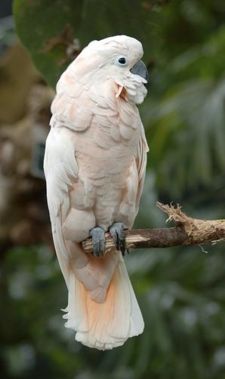Moluccan Cockatoo
Conservation status: Vulnerable |

|
|
Scientific classification |
| Kingdom: |
Animalia
|
| Phylum: |
Chordata
|
| Class: |
Aves
|
| Order: |
Psittaciformes
|
| Family: |
Cacatuidae
|
| Subfamily: |
Cacatuinae
|
| Genus: |
Cacatua
|
| Subgenus: |
Cacatua
|
| Species: |
C. moluccensis
|
|
|
Binomial name |
Cacatua moluccensis
Gmelin, 1788 |
The Moluccan Cockatoo, Cacatua moluccensis
also known as Salmon-crested Cockatoo is a
cockatoo
endemic to south Moluccas in eastern Indonesia. At 50 cm, it is the largest of the white
cockatoos. The female is larger than the males on
average. It has white-pink feathers with a definite peachy
glow, a slight yellow on the underwing and a large
retractable recumbent crest which it raises when threatened
to frighten potential attackers. It also has a loud voice
and in captivity is a capable mimic.
In the wild the Moluccan Cockatoo inhabits lowland
forests below 1000m. The diet consists mainly of seeds, nuts
and fruit, as well as coconuts.
Endangered status in the wild
The Moluccan Cockatoo is an endangered species, and has
been listed on appendix I of CITES since 1989, which makes
trade in wild-caught birds illegal. Trade in captive bred
birds is legal only with appropriate CITES certification.
Numbers have declined due to illegal trapping for the
cage-bird trade and habitat loss. During the height of the
trapping of this species over 6,000 birds were being removed
from the wild per year. It has a stronghold in Manusela
National Park on Seram, although even today some illegal trapping
continues.
Aviculture
The Moluccan Cockatoo can no longer be imported into the
United States because of its being listed on the Wild Bird
Conservation Act. However they are being bred in captivity.
The potential owner should be aware of the bird's needs, and
know how loud these birds can be.
References
- BirdLife International (2004).
Cacatua moluccensis. 2006
IUCN Red List of Threatened Species. IUCN 2006. Retrieved on 11 May 2006. Database entry
includes justification for why this species is
vulnerable
External links




